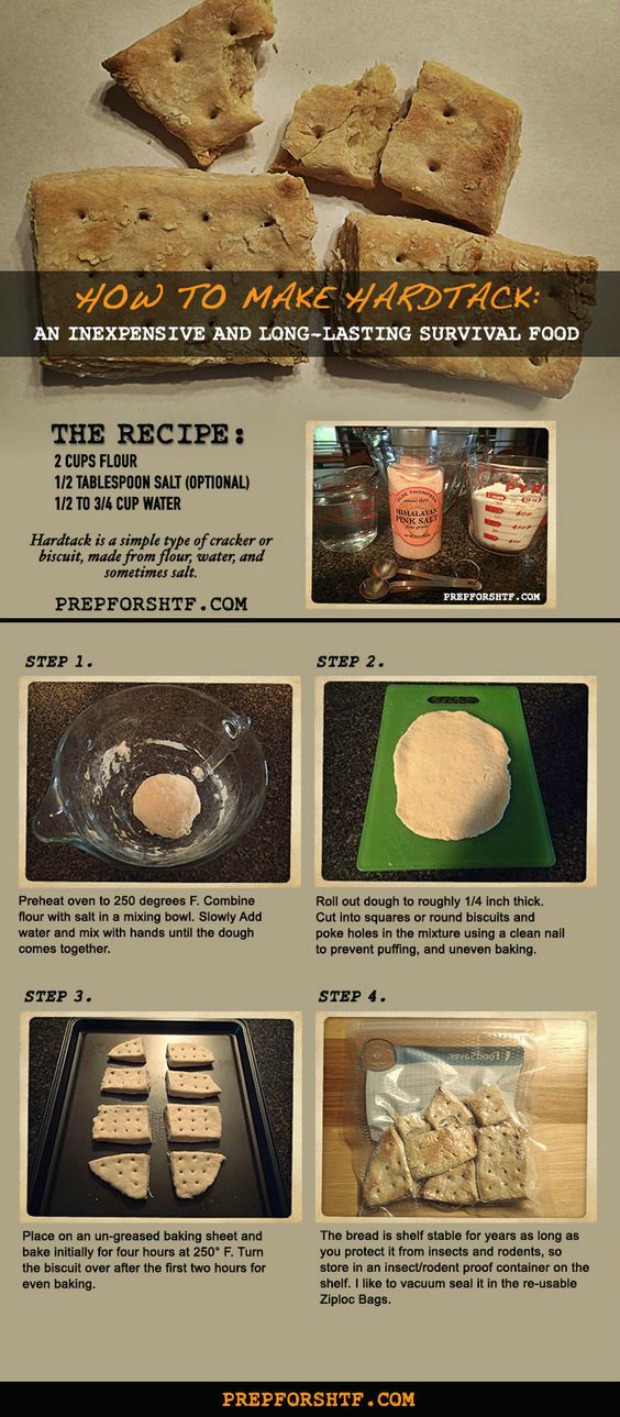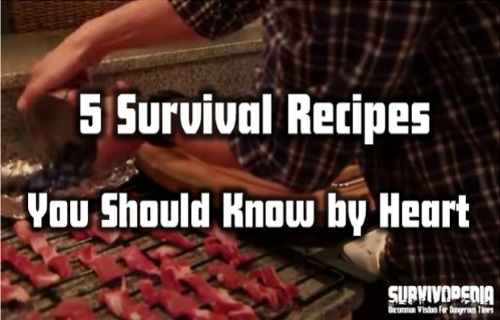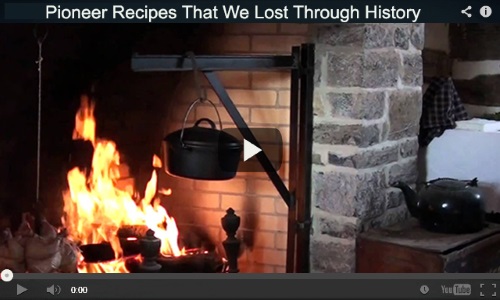What do you do now if you want a recipe for something you don’t know how to make? You go to the internet, or perhaps to a cookbook, though that’s becoming a rarity.
However, if you’re faced with an emergency where you have no power or no access to your cookbooks, you’ll have to know how to make some basics from memory.
Today, I’m going to tell you about 5 foods that will help you fill bellies in an emergency situation. Memorize them!
Pemmican
This is crazy simple to make, and was a staple food for Native Americans. It stores well and contains enough nutrients that you can effectively survive off it for a long time. It’s also easy to carry and doesn’t require refrigeration, which is why it was a staple for nomadic tribes or for hunters.
Traditional pemmican has three primary components: fat, lean dried meat, and dried fruit. That’s it. Add some flavor, nutrition, and texture by adding honey and nuts.
Tip:
Don’t use pork or bear for this recipe due to high fat content of the meat. Use any other lean meat, including beef, venison, caribou, or moose. Here’s how to make it.
Ingredients:
- 2 cups dried crushed meat
- 2 cups dried crushed berries or dates
- 1 cup melted fat
- 1/2 cup crushed nuts
- 1/4 cup honey
Instructions:
Trim all of the fat off the meat, then dry in a dehydrator until it cracks and breaks. If it bends, there’s still too much moisture in it. Do the same thing with the berries. Render the fat into a liquid form and crush your nuts. You can grind them if you want, or leave them a bit chunky to add texture.
Crush the meat and berries into a fine powder. Using your blender or food processor for now will work better but if you’re making it without power, just grind them with a pestle. If the meat is a challenge, use the pestle or a hammer, or even your fingers to get the meat as finely ground as you can.
Add enough fat to the meat and berries (and the nuts if you’re using them) to make it stick together; no more. Add enough honey that it’s sweetened but not overly sticky.
Roll it out and cut it into bars, or do it as the Native Americans did and roll it into balls. Store in a bag in a cool, dry place.
In the video bellow you can discover the great Pemmican recipe inspired by The Lost Ways guide. You can prepare right now this delicious pemmican.
Many other survival secrets and recipes that helped our ancestors survive gloomy days are about to be discovered in “The Lost Ways” book. CLICK HERE for more information about this awesome survival book!
Hardtack
If you’re like me, when you hear the term hardtack, you might think of candy, but traditional hardtack is basically a cracker that will last practically forever as long as it stays dry. Cowboys carried hardtack with them to eat when they had nothing else. It was a staple for soldiers on long military campaigns.
It’s not as nutritious as pemmican, but it will fill the hole in your belly and provide you with carbs that you need to keep moving. It’s extremely hard, which explains the nickname “molar breakers”, and is easier to eat if you dip it in your coffee or water or add it to your soup.
Hardtack is extremely simple to make and consists of only three ingredients. You can cook it on the trail, too. Some recipes call for milk, sugar, and butter, but those ingredients significantly reduce the shelf life.
Ingredients:
- 3 cups all-purpose flour
- 2 tsp. salt
- 1 cup water
Preheat oven to 375 degrees F. Combine the salt and flour, then add the water. The dough shouldn’t stick to your hands, so either add the water a bit at a time, or add a bit more flour if it’s sticky.
Roll the dough out into a rectangle until it’s no more than 1/2 inch thick. Cut the dough twice lengthwise and twice across the width into 9 equal squares, then use a nail to poke 12 holes (a 4×4 grid) into each square.
Place each square onto a cookie sheet or into your Dutch oven or covered iron skillet if you’re cooking on the trail. Bake for 30 minutes on each side. Remove from oven and allow to cool. Store in an airtight container.

Beans and Rice
Though this recipe is extremely simple, it’s packed with nutrients and is a complete meal. If you’d like, throw in some bacon or some cayenne to taste to spice it up.
Ingredients:
- Equal parts beans and rice (not instant or quick-cook). Any type of beans will work, but pintos, great northerns, or black beans are exceptionally good.
- Salt and pepper to taste – start with a teaspoon per cup and add until it suits your taste.
- Three times as much water as you have beans and rice
Instructions:
Rinse the beans and let them sit overnight. The next day, bring to a simmer and let them cook until the beans are still slightly crunchy, but starting to get tender – about 2 hours. Add rice and cook for another 30 minutes. If you’d like, throw in some bacon when you start cooking the beans. Add spices such as cayenne pepper, onion (fresh or powdered) or garlic to suit your tastes.
Trail Biscuits
You can make biscuits in your oven or in your Dutch oven or a skillet on the trail. Though ingredients such as buttermilk make them fluffier and more delicious, you can make biscuits with much simpler ingredients. These are heavier, but still soft and go great with gravy.
This is a stick-to-your-ribs food that will help stretch rations or fill bellies. The eggand lard is optional, but if you’re not using lard, substitute the baking powder for a couple of teaspoons of baking soda.
Ingredients:
- 3 1/2 cups all-purpose flour
- 2 tbsp. baking powder
- 1 egg (optional if available)
- 1 tsp salt
- 1/2 cup butter or lard
- 1 – 11/2 cups milk
Preheat oven to 370 degrees F. or stoke your coals so that they’re hot enough to cook in.
Combine flour, salt, and baking powder in a bowl, then cut the cold butter or lard (bacon grease actually makes them delicious, but heavy) into the flour mixture until you have pea-sized pieces. Add milk until dough is barely sticky. Don’t overmix or your biscuits will be tough.
Drop about 1/4 cup at a time into a greased pan or Dutch oven.
Cook for 20 minutes or so until biscuits are brown. If using a Dutch oven, put the biscuits in, then put the lid on the oven and bury in the coals for 15-20 minutes.
Sausage Gravy
This recipe can be modified to use bacon, hamburger, or just about any other meat, but you will need a fat source. That means that venison is likely out unless you have some bacon grease or other flavored grease because that’s where the flavor comes from.
Though this recipe calls for milk, I’ve made gravy with only water. It’s not nearly as good, but it’s edible. It’s better to carry some dried milk than to skip the milk altogether. You can also use all milk, but when it’s in short supply, the amount listed will do just fine.
Ingredients:
- 1 pound sausage
- 1/4 cup all-purpose flour
- 1 tsp salt
- 1 tsp black pepper
- 1 cup milk
- 1 1/2 cups water
Directions:
Fry the sausage, crumbling it up with the spatula as you cook it.
Sprinkle flour, salt, and pepper over the sausage and allow to brown, stirring as you go. Smash it with the back of the spatula to keep it from clumping.
Add the water a 1/2 cup at a time, stirring and smashing with the spatula well to prevent lumps. Once you have it smooth and it’s turning from a thick paste into a thin paste, pour the milk in, stirring vigorously as you do.
Gravy is easy. You don’t have to use exact amounts. Just add enough flour to make the grease a thick paste, then add enough milk and water to bring it to a gravy consistency. If it starts to get thin, stop adding liquid. If it’s too thick, add more. Remember that it will thicken slightly as it cools.

There are many different easy recipes that you should learn so that you can make them off the top of your head. Fried cornmeal mush is one that I can think of. Cornbread is another.
Remember that in all recipes, dried milk, dried eggs, and dried butter are all perfect substitutes for fresh ingredients and will make your recipe better than if you don’t have it at all.
Eventually, you’ll have to make it up whatever you have on hand, just like our ancestors did in times of need. Click on the banner below to find out more about the way they survived during hard times!
This article has been written by Theresa Crouse for Survivopedia.
“MY SURVIVAL FARM”
…and it’s like nothing you’ve ever seen before… An A to Z guide on survival gardening that is easy to read and a joy to put into practice, full of photos, diagrams and step by step advice. Even a kid can do this and, in fact, I encourage you to let the little ones handle it, to teach them not just about self-reliance but also about how Mother Nature works.
Here is just a glimpse of what you’ll find inside:
How to plan, design and put into action high-yield survival garden that will literally keep you and your family fed for life, no matter what hits you, even when everyone else around you is starving to death. No digging and planting year after year and no daily watering because you’ll have more important things to worry about when TSHTF.
How to set up highly nutritious soil for your plants. Do this before you plant anything and you’re on your way to setting your food forest on auto-pilot for decades to come. I’m gonna tell you this one “weird” thing to add to the mulch that’s not only highly effective but also 100% free (because you already have it in your home right now).
Step-by-step instructions on how to plant over 125 plants inside your permaculture garden. Plus, special instructions on choosing the right ones for your climate. From Arizona to Alaska, you can do this anywhere…
How to “marry” your plants. We’re gonna tell you which grow well together and help each-other survive and thrive, so they don’t ever compete for sunlight and nutrients. You get the full table of plants that work well with one another as well as the ones you should NEVER be put together.
Our grandfathers had more knowledge than any of us today and thrived even when modern conveniences were not available. They were able to produce and store their food for long periods of time. The Lost Ways is the most comprehensive book available. All the knowledge our grandfathers had, in one place.Here’s just a glimpse of what you’ll find in the book:
Table Of Contents:
Making Your Own Beverages: Beer to Stronger Stuff
Ginger Beer: Making Soda the Old Fashioned Way
How North American Indians and Early Pioneers Made Pemmican
Wild West Guns for SHTF and a Guide to Rolling Your Own Ammo
How Our Forefathers Built Their Sawmills, Grain Mills,and Stamping Mills
How Our Ancestors Made Herbal Poultice to Heal Their Wounds
What Our Ancestors Were Foraging For? or How to Wildcraft Your Table
How North California Native Americans Built Their Semi-subterranean Roundhouses
Our Ancestors’Guide to Root Cellars
Good Old Fashioned Cooking on an Open Flame
Learning from Our Ancestors How to Preserve Water
Learning from Our Ancestors How to Take Care of Our Hygiene When There Isn’t Anything to Buy
How and Why I Prefer to Make Soap with Modern Ingredients
Temporarily Installing a Wood-Burning Stove during Emergencies
Making Traditional and Survival Bark Bread…….
Trapping in Winter for Beaver and Muskrat Just like Our Forefathers Did
How to Make a Smokehouse and Smoke Fish
Survival Lessons From The Donner Party
Get your paperback copy HERE
Here’s just a glimpse of what you’ll find in The Lost Ways:
From Ruff Simons, an old west history expert and former deputy, you’ll learn the techniques and methods used by the wise sheriffs from the frontiers to defend an entire village despite being outnumbered and outgunned by gangs of robbers and bandits, and how you can use their wisdom to defend your home against looters when you’ll be surrounded.
Native American ERIK BAINBRIDGE – who took part in the reconstruction of the native village of Kule Loklo in California, will show you how Native Americans build the subterranean roundhouse, an underground house that today will serve you as a storm shelter, a perfectly camouflaged hideout, or a bunker. It can easily shelter three to four families, so how will you feel if, when all hell breaks loose, you’ll be able to call all your loved ones and offer them guidance and shelter? Besides that, the subterranean roundhouse makes an awesome root cellar where you can keep all your food and water reserves year-round.
From Shannon Azares you’ll learn how sailors from the XVII century preserved water in their ships for months on end, even years and how you can use this method to preserve clean water for your family cost-free.
Mike Searson – who is a Firearm and Old West history expert – will show you what to do when there is no more ammo to be had, how people who wandered the West managed to hunt eight deer with six bullets, and why their supply of ammo never ran out. Remember the panic buying in the first half of 2013? That was nothing compared to what’s going to precede the collapse.
From Susan Morrow, an ex-science teacher and chemist, you’ll master “The Art of Poultice.” She says, “If you really explore the ingredients from which our forefathers made poultices, you’ll be totally surprised by the similarities with modern medicines.” Well…how would you feel in a crisis to be the only one from the group knowledgeable about this lost skill? When there are no more antibiotics, people will turn to you to save their ill children’s lives.
If you liked our video tutorial on how to make Pemmican, then you’ll love this: I will show you how to make another superfood that our troops were using in the Independence war, and even George Washington ate on several occasions. This food never goes bad. And I’m not talking about honey or vinegar. I’m talking about real food! The awesome part is that you can make this food in just 10 minutes and I’m pretty sure that you already have the ingredients in your house right now.
Really, this is all just a peek.
The Lost Ways is a far–reaching book with chapters ranging from simple things like making tasty bark-bread-like people did when there was no food-to building a traditional backyard smokehouse… and many, many, many more!
Books can be your best pre-collapse investment.
The Lost Ways (Learn the long forgotten secrets that helped our forefathers survive famines,wars,economic crisis and anything else life threw at them)
Survival MD (Best Post Collapse First Aid Survival Guide Ever)
Conquering the coming collapse (Financial advice and preparedness )
Liberty Generator (Build and make your own energy source)
Backyard Liberty (Easy and cheap DIY Aquaponic system to grow your organic and living food bank)
Bullet Proof Home (A Prepper’s Guide in Safeguarding a Home )
Family Self Defense (Best Self Defense Strategies For You And Your Family)
Survive Any Crisis (Best Items To Hoard For A Long Term Crisis)
Survive The End Days (Biggest Cover Up Of Our President)





